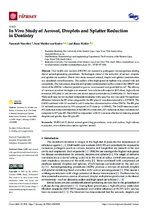In vivo study of aerosol droplets and splatter reduction in dentistry
Abstract
Oral healthcare workers (OHCW) are exposed to pathogenic microorganisms during dental aerosol-generating procedures. Technologies aimed at the reduction of aerosol droplets and splatter are essential. This in vivo study assessed aerosol droplets and splatter contamination in a simulated clinical scenario. The coolant of the high-speed air turbine was colored with red concentrate. The red aerosol droplets and splatter contamination on the wrists of the OHCW and chests of the OHCW/volunteer protective gowns were assessed and quantified in cm2. The efficacy of various evacuation strategies were assessed: low-volume saliva ejector (LV) alone, high-volume evacuator (HV) plus LV, and an extra-oral dental aerosol suction device (DASD) plus LV. The Kruskal– Wallis rank-sum test for multiple independent samples with a posthoc test was used. No significant difference between the LV alone compared to the HV plus LV was demonstrated (p = 0.372059). The DASD combined with LV resulted in a 62% reduction of contamination of the OHCW. The HV plus LV reduced contamination by 53% compared to LV alone (p = 0.019945). The DASD demonstrated a 50% reduction in the contamination of the OHCWs wrists and a 30% reduction in chest contamination compared to HV plus LV. The DASD in conjunction with LV was more effective in reducing aerosol droplets and splatter than HV plus LV. © 2021 by the authors. Licensee MDPI, Basel, Switzerland.

